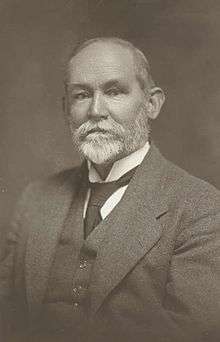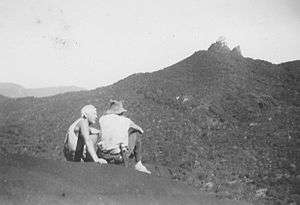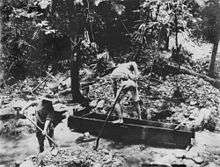Mount Pieter Botte
Mount Pieter Botte, also known as Ngalba-bulal,[3] Alpaboolal (meaning big top), or Barbar (meaning elder sister),[4] or Ginpure (meaning younger sister),[5] is a mountain in the tableland region behind Cape Tribulation in Far North Queensland, Australia. It was named in 1848 by Captain Owen Stanley of the survey ship HMS Rattlesnake. The name was chosen by those on board the Rattlesnake. (from Voyage of Rattlesnake page 104) because of its resemblance to Peter Botte Mountain, a famous peak on the island of Mauritius.[6][7] The mountain is part of the Wet Tropics of Queensland World Heritage Site.[8] There are two peaks, a northern peak and a southern peak. The South Peak is the highest point and the true summit of Mount Pieter Botte.[1]

| Mount Pieter Botte | |
|---|---|
 Mount Pieter Botte in 1935 | |
| Highest point | |
| Elevation | 1,047[1] m (3,435 ft) [2] |
| Coordinates | 16°04′S 145°24′E |
| Geography | |
 Mount Pieter Botte Shire of Douglas, Queensland, Australia | |
| Parent range | Great Dividing Range |
Australian Aborigines in the area were reported to believe that the mountain was home to their ancestral spirits.[7]

Six Kuku Yalanji people, led by an elder,[4] guided three Europeans up the climb in October 1896, the visiting botanist-cum-explorer Dudley Le Souef, Frank Hislop and Mr. Anderson.[4][7] They climbed the North Peak and then climbed to the platform below the summit of Mount Pieter Botte (South Peak).[4][7] This was the first recorded European party to climb the North Peak.[7] The South Peak itself is a sheer-sided granite outcrop which was not climbed.[4][7]
On 26 August 1938, Walter Mason, Wilfred Knight and Douglas Mason also climbed the tableland behind Cape Tribulation to the base of Mount Pieter Botte.
Flora and fauna
Le Souef's expedition recorded riflebirds, catbirds, pittas, Spalding's orthonyx, shrikethrushes, Australian brushturkeys, Quoy's butcher bird, sulphur-crested cockatoos, superb fruit doves and tree kangaroos.[4][7]
The wingless water bug Austrovelia queenslandica is known only from this area.[8] Armoured Mistfrogs (Litoria lorica), a critically endangered species, have been observed in Roaring Meg Creek, just below Mount Pieter Botte.[9]
A species of a Medicosma mountain rainforest understorey tree is known only from one sample in the Mount Pieter Botte area.[10] Eidothea zoexylocarya is a large tree that only grows in the mountain rainforests of north-eastern Queensland, including Mount Pieter Botte.[11][12] Romnalda ophiopogonoides is an endangered plant with only around 500 individuals known, including some around Roaring Meg Creek near the mountain.[13]
See also
- List of mountains of Australia
References
- "QTopo". Queensland Spatial Catalogue - QSpatial. Retrieved 3 January 2020.
- Favenc, Ernest (1888). The History of Australian Exploration from 1788 to 1888. Retrieved 2 November 2013.
- Bloomfield, Toby; Friday, Ruby; Roberts, Bobby; Sykes, Harry & Dolly; Walker, Johnny; The people who lived at Jajikal in Ayton (September 1986). Hershberger, Henry D.; Hershberger, Ruth (eds.). Kuku Yalanji Dictionary [Kuku Yalanji to English] (PDF online version). Work papers of SIL-AAB Series B. 7. Summer Institute of Linguistics. p. 124. ISBN 0-86892-238-2. Retrieved 2 November 2013.
- Le Souef, Dudley (March–April 1897). "Ascent of Mt. Peter Botte, North Queensland". The Victorian Naturalist. (online digitised original, via biodiversitylibrary.org). 13 (12): 151–167. Retrieved 2 November 2013.
- "Situated in the deep, pristine and seemingly..." Janine Bächle. Retrieved 3 January 2020.
- "Queensland Coast Names". The Morning Bulletin. Rockhampton, Qld.: National Library of Australia. 13 July 1929. p. 14. Retrieved 2 November 2013.
- "Wild Nature's Ways". Townsville Daily Bulletin. Qld.: National Library of Australia. 26 October 1946. p. 5. Retrieved 2 November 2012.
- "Draft Wet Tropics Periodic Report" (PDF). Australian Government Department of Sustainability, Environment, Water, Population and Communities. 2001. Retrieved 2 November 2013.
- "Advice to the Minister for the Environment and Heritage from the Threatened Species Scientific Committee (the Committee) on Amendments to the list of Threatened Species under the Environment Protection and Biodiversity Conservation Act 1999 (EPBC Act)" (PDF). Australian Government Department of Sustainability, Environment, Water, Population and Communities. Retrieved 2 November 2013.
- Hyland, B. P. M.; Whiffin, T.; Zich, F. A.; et al. (December 2010). "Factsheet – Medicosma sp. Pieter Botte (B.Hyland 3503RFK)". Australian Tropical Rainforest Plants (6.1, online version RFK 6.1 ed.). Cairns, Australia: Commonwealth Scientific and Industrial Research Organisation (CSIRO), through its Division of Plant Industry; the Centre for Australian National Biodiversity Research; the Australian Tropical Herbarium, James Cook University. Retrieved 2 November 2013.
- Hyland, B. P. M.; Whiffin, T.; Zich, F. A.; et al. (December 2010). "Factsheet – Eidothea zoexylocarya". Australian Tropical Rainforest Plants (6.1, online version RFK 6.1 ed.). Cairns, Australia: Commonwealth Scientific and Industrial Research Organisation (CSIRO), through its Division of Plant Industry; the Centre for Australian National Biodiversity Research; the Australian Tropical Herbarium, James Cook University. Retrieved 2 November 2013.
- Weston, Peter H.; Kooyman, Robert M. (2003). "Botany and Ecology of the 'Nightcap Oak', Eidothea hardeniana". Australian Plants. (online version). Association of Societies for Growing Australian Plants. Archived from the original on 6 August 2012. Retrieved 2 November 2013.
- Conran, John G.; Forster, Paul I.; Donnon, Matthew (2008). "Romnalda ophiopogonoides (Asparagales: Laxmanniaceae), a new and endangered species from the Wet Tropics bioregion of north-east Queensland" (PDF). Telopea. The Royal Botanic Gardens & Domain Trust. 12 (2): 167–178. doi:10.7751/telopea20085808. Archived from the original (PDF) on 3 November 2013. Retrieved 2 November 2013.